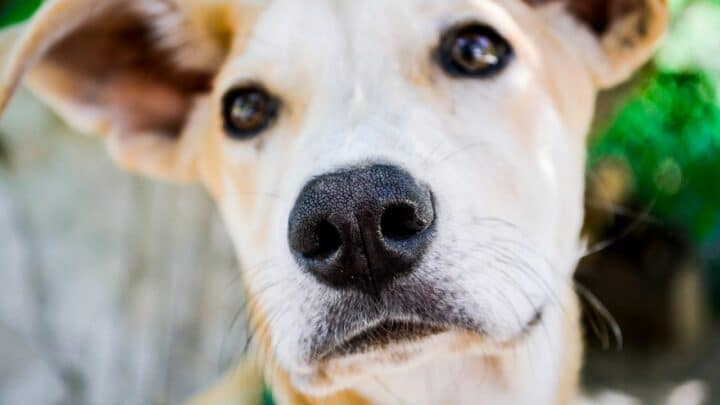The world is more obsessed with dogs than it has ever been.
Annually, humans spend billions of dollars on our canine friends, and we take to search engines and Reddit threads to answer any canine questions that we have, whether it be health or training-related.
One of the most extensive internet searches has to do with moles on dogs‘ faces.
Owners on a global scale are wondering why all dogs have moles in the same spots on their faces, regardless of breed or bloodline, while other searches focus on potential moles and growth and when owners should be worried.
Moles on Dogs Faces
Moles on your dog’s face that have been there since birth do not pose any health threat or potential medical issue. They’re called vibrissae, and they contain a mass of sensitive nerves under the surface of the skin. They act like whiskers, responsible for helping dogs feel the world around them.
Recognizing Moles that Belong
Your dog was born with moles on its face that help it determine its environment through the sense of touch.
Dogs can feel with their whole bodies, but their whiskers and vibrissae moles are incredibly sensitive, allowing more information about their world.
There is no need to worry if you spot moles on your dog that have been there all along. These moles present from birth aren’t technically moles but instead a tool that helps them feel their way through life.
Of course, if a mole pops up on your dog’s face that you’re unsure of, it’s not a bad idea to have a vet take a look. Dogs develop skin conditions just like humans do, so if your pup has a growth that looks like a mole that you’ve never noticed before, you’ll want to monitor it.
Types of Moles on Dogs’ Faces
Dogs can develop moles and skin growth anywhere on their bodies, the face included. Most of these skin issues aren’t a cause for concern.
They’re widespread and come in a few different forms.
Skin Tags
Skin tags are just as prevalent on canines as they are on the human race. Skin tags have a wart-like appearance, but they’re more flexible, sticking outward from the skin.
If you think your dog has a skin tag, try moving the growth back and forth, as skin tags are typically able to move somewhat freely.
Unless they become infected or inflamed for some reason, skin tags rarely need attention.
You can have them removed by your vet if they’re in a strange spot, such as right on the eyelid or inner ear, causing an issue with everyday activity.
If your pup has a skin tag in an area that he itches quite a bit, it’s likely to cause infection. Talk to your vet about the best plan of action in this case.
Moles
Moles are common on dogs, even new ones. Moles can appear anywhere on the body, which is all they have in common with skin tags.
Moles on a dog, much like moles on a human, will not be flexible or easy to move. Moles are slow-growing and more common in dogs that spend time in the sun.
Moles on dogs are flat and hard and typically benign, but it doesn’t hurt to be on the lookout for changes in new or long-standing moles.
Cancerous Skin Growths
There is a chance that a mole on your dog’s face could turn cancerous. The chances of a dog contracting skin cancer in dogs double as they age and is more likely in purebreds.
Early treatment is vital, so if you see something out of the ordinary on your pup, take it in for an evaluation.
Tumors
Malignant tumors are possible in canines, and they can begin with moles on the face or body. Like humans, dogs can have localized and metastasized tumors.
Most skin cancer form in dogs are mast cell tumors, and they have a wide prognosis range, varying from utterly benign to aggressive.
The appearance of malignant tumors can vary, so if you notice changes in your dog’s skin on any level, you should definitely make a vet appointment.
It’s better to be safe than sorry!
Frequently Asked Questions about Moles on Dogs Faces
How can I tell if a mole on my dog’s face is cancer?
Chances are, the mole on your dog’s face is not cancer. Don’t scare yourself silly. Get a professional opinion before you worry! If the mole in question is not in a vibrous location or changing shape, size, and color, you should see your vet for further evaluation.
What do the moles my dog was born with function for?
Some dogs are born with moles, just like people, and there is no purpose for them other than that’s how the skin develops. However, when referring to the vibrissal spots on dogs’ faces that look like moles, we can say that those are there to increase the sense of touch.
When should my dog see a vet for a mole?
If the mole is changing or growing, your dog should see a vet. Also, if the mole is in a bothersome spot to your pup, it doesn’t hurt to have it removed.
Moles and Dogs
Dogs rarely go a lifetime without developing some sort of mole or skin tag on their bodies. The face isn’t excluded from this rule.
Some moles serve a purpose, and others do not, but they are completely normal and harmless for the most part.


